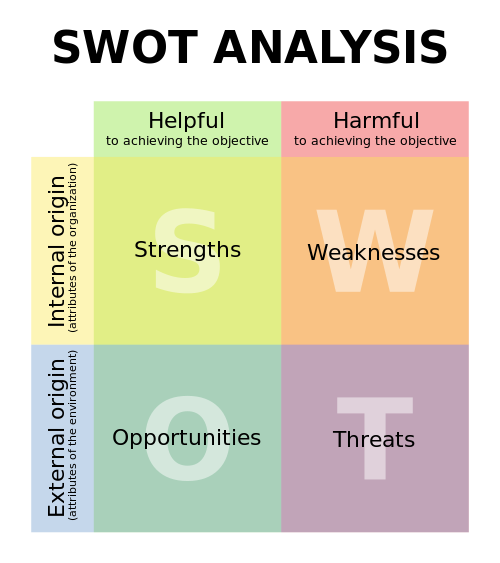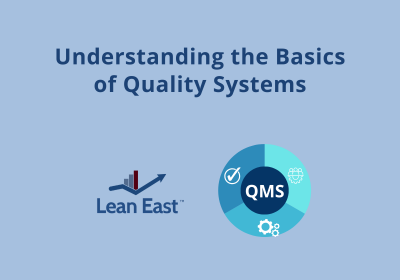Brainstorming to assess organizational strengths, weaknesses, opportunities, and threats (SWOT)
The Lean East team was recently hired to facilitate several meetings for mid-large size organizations seeking managerial input to their strategic planning process. In short, we conducted SWOT Analysis sessions with these teams. As a result, we discovered how the leaders perceived the organization’s strengths, weaknesses, opportunities, and threats. We will share the process and the agenda we used for this informative brainstorming technique, therefore helping you plan your own session.
SWOT is an acronym for strengths, weaknesses, opportunities, and threats. It can be used to study a person, product, service, team, or organization. SWOT analysis considers both internal and external factors. For example, strengths and weaknesses consider the factors that are inside of the organization. On the other hand, opportunities and threats focus on business and market factors external to the organization. Overall, the results of a SWOT analysis lead to the identification of strategic priorities. In order the achieve your goals, these priorities must be undertaken.

Suggested pre-session preparation
Most importantly, attendees should understand the purpose of the SWOT and prepare in advance for the session. It’s helpful for attendees to consider their own list of strengths, weaknesses, opportunities, and threats before the meeting. Similarly, leaders may want to query their staff for thoughts or ask customers to provide input. Remember to explain that strengths and weaknesses are internal to the organization, while opportunities and threats are external factors.
For every strength, weakness, opportunity, or threat you identify, imagine a little person on your shoulder asking, “How do you know?” Most importantly, you should be looking to confirm (or disconfirm) the data that supports your position in advance of the meeting. For example, if you believe an organizational strength is that “the marketing team is very skilled and experienced,” ask “How do you know?” What evidence or proof is there that this is true? What data backs up this claim? This preparation will make for a very productive and also enlightening session.
A suggested schedule for the SWOT session
First, the agenda we recommend for a SWOT session includes an introduction (possibly with an ice breaker) where the agenda and ground rules for the brainstorming session are covered. This is also a great time to review the organization’s mission and the vision statement and post it on a wall in the room. The morning schedule also includes brainstorming sessions on each of the SWOT topics. Then, after all the ideas for a topic have been raised and explained, we recommend asking the team to vote for their priorities. During the break for lunch, the top four or five priorities are combined into a single page to display the four SWOT topics together. Our agenda for the day is shown below.
| Agenda item | Timing |
| Introductions, objective, and purpose | 10 min |
| Mission and vision statements | 5 min |
| Cover ground rules | 5 min |
| Brainstorm strengths | 30 min |
| Brainstorm weaknesses | 30 min |
| Break | 10 min |
| Brainstorm opportunities | 30 min |
| Brainstorm threats | 30 min |
| Review and order top 5 ideas | 20 min |
| Lunch (combine top ideas into one view) | 40 min |
| Display all top 5 ideas and identify linkages | 30 min |
| Identify actions based on SWOT | 60 min |
| Break | 15 min |
| Create a prioritized action plan | 60 min |
Next, is the afternoon session. This is a time to reflect on the top priorities identified through brainstorming and also look for duplication and linkages.
Common focus areas for the team can be:
- Where do Strengths and Opportunities align? These may indicate growth areas where the team is positioned to exploit advantages.
- Where do Weaknesses and Threats align? Watch out! How will you deal with these risks?
- What Weaknesses are negating your natural Strengths? For example, a customer service culture strength could be erased by poor customer contact processes or systems.
- Are there Weaknesses that can become Strengths through focused effort?
Finally, the remainder of the session can be used to create a prioritized action plan. We recommend focusing on SMART goals, with ownership for each objective assigned to a member of the leadership team.
SWOT Strategic Planning
In short, SWOT sessions are an excellent introduction to a leadership retreat or annual strategic planning meeting. A team that repeats these sessions annually may wish to begin the afternoon of a SWOT session with a comparison of the morning SWOT results with the previous year’s results to identify changes. SWOT sessions are similar to any brainstorming exercise. Therefore, they are best completed by teams using outside facilitation so everyone has an equal chance to participate. One may also complete a SWOT analysis individually. Be sure to remember to ask, “How do I know?” for everything you believe to be true.
Please let us know when you complete a SWOT analysis session of your own using these tips.




